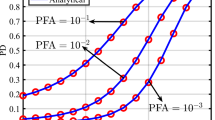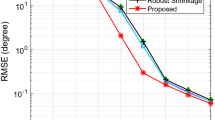Abstract
In this paper, we consider the problem of detecting a distributed target in unknown disturbance. The signals reflected by the target are assumed to come from the same direction. However, the exact direction is unknown and yet the signal steering vector lies in a known subspace. The disturbance consists of colored noise and deterministic interference. The interference belongs to a known subspace, linearly independent on the signal subspace. We derive the one-step Wald test and two-step Wald test. Numerical examples show that the proposed detectors can achieve better detection performance than the existing detectors.






Similar content being viewed by others
Notes
The 1S- and 2S-Wald tests are both based on the criterion of the Wald test. However, the former is obtained by using the joint estimates of all unknown parameters. In contrast, the latter is obtained in two steps. It first obtains the Wald test on the assumption of known noise covariance matrix. Then the covariance matrix is replaced by a suitable estimate, which is usually the sample covariance matrix (SCM).
We find that the GLRT and 2S-GLRT can be written as the forms directly with the original data, which are given in the Appendix.
In Figs. 3 and 4, the noise covariance matrix has the form of (63), while in Fig. 5 the noise covariance matrix has the form \(\mathbf{R}={\mathbf{R}_c}+{\mathbf{R}_n}\), where \(\mathbf{R}_c\) is the clutter covariance matrix and \(\mathbf{R}_n\) is the thermal noise covariance matrix. Moreover, \(\mathbf{R}_c\) and \(\mathbf{R}_n\) have the forms \(\mathbf{R}_c=\mathbf{U}_c\varvec{\Lambda }\mathbf{U}_c^H\) and \(\mathbf{R}_n=\gamma \mathbf{I}_N\), respectively. \(\mathbf{U}_c\) is and \(N\times r\) semi-unitary matrix satisfying \(\mathbf{U}_c^H\mathbf{U}_c=\mathbf{I}_r\). \(\varvec{\Lambda }=\text {diag}(\lambda _1,\lambda _2,\ldots ,\lambda _r)\) is an \(r\times r\) diagonal matrix, with the diagonal elements being the clutter eigenvalues, standing for the clutter power. \(\gamma \) is the noise eigenvalue, denote the thermal noise power. The clutter-to-noise ratio is defined as \(\text {CNR} =\frac{\sum _{i=1}^{r}\lambda _i}{N\gamma }\). Note that the noise model for Fig. 5 is usually encountered by airborne radar when space-time adaptive processing (STAP) is adopted.
References
Bandiera, F., Besson, O., Orlando, D., Ricci, G., & Scharf, L. L. (2007). GLRT-based direction detectors in homogeneous noise and subspace interference. IEEE Transactions on Signal Processing, 55(6), 2386–2394.
Bandiera, F., Besson, O., & Ricci, G. (2013). Direction detector for distributed targets in unknown noise and interference. Electronics Letters, 49(1), 68–69.
Bandiera, F., De Maio, A., Greco, A. S., & Ricci, G. (2007). Adaptive radar detection of distributed targets in homogeneous and partially homogeneous noise plus subspace interference. IEEE Transactions on Signal Processing, 55(4), 1223–1237.
Besson, O., Scharf, L. L., & Kraut, S. (2006). Adaptive detection of a signal known only to lie on a line in a known subspace, when primary and secondary data are partially homogeneous. IEEE Transactions on Signal Processing, 54(12), 4698–4705.
Bose, S., & Steinhardt, A. O. (1996). Adaptive array detection of uncertain rank one waveforms. IEEE Transactions on Signal Processing, 44(11), 2801–2809.
Ciuonzo, D., De Maio, A., & Orlando, D. (2016). A unifying framework for adaptive radar detection in homogeneous plus structured interference—part I: On the maximal invariant statistic. IEEE Transactions on Signal Processing, 64(11), 2894–2906.
Ciuonzo, D., De Maio, A., & Orlando, D. (2016). A unifying framework for adaptive radar detection in homogeneous plus structured interference—part II: Detectors design. IEEE Transactions on Signal Processing, 64(11), 2907–2919.
Ciuonzo, D., De Maio, A., & Orlando, D. (2017). On the statistical invariance for adaptive radar detection in partially-homogeneous disturbance plus structured interference. IEEE Transactions on Signal Processing, 65(5), 1222–1234.
Conte, E., Lops, M., & Ricci, G. (1995). Asymptotically optimum radar detection in compound-Gaussian clutter. IEEE Transactions on Aerospace and Electronic Systems, 31(2), 617–625.
Conte, E., De Maio, A., & Ricci, G. (2001). GLRT-based adaptive detection algorithms for range-spread targets. IEEE Transactions on Signal Processing, 49(7), 1336–1348.
Cui, G., Kong, L., & Yang, X. (2010). Multiple-input multiple-output radar detectors design in non-Gaussian clutter. IET Radar, Sonar and Navigation, 4(5), 724–732.
Cui, G., Liu, J., Li, H., & Himed, B. (2015). Signal detection with noisy reference for passive sensing. Signal Processing, 108, 389–399.
De Maio, A. (2007). Rao test for adaptive detection in Gaussian interference with unknown covariance matrix. IEEE Transactions on Signal Processing, 55(7), 3577–3584.
De Maio, A., & Iommelli, S. (2008). Coincidence of the Rao test, and Wald test, and GLRT in partially homogeneous environment. IEEE Signal Processing Letters, 15, 385–388.
De Maio, A., & Orlando, D. (2016). Adaptive radar detection of a subspace signal embedded in subspace structured plus Gaussian interference via invariance. IEEE Transactions on Signal Processing, 64(8), 2156–2167.
Frontera-Pons, J., Pascal, F., & Ovarlez, J.-P. (2017). Adaptive nonzero-mean Gaussian detection. IEEE Transactions on Geoscience and Remote Sensing, 55(2), 1117–1124.
Gao, Y., Liao, G., & Liu, W. (2016). High-resolution radar detection in interference and nonhomogeneous noise. IEEE Signal Processing Letters, 23(10), 1359–1363.
Gao, Y., Li, H., & Himed, B. (2017). Knowledge-aided range-spread target detection for distributed MIMO radar in nonhomogeneous environments. IEEE Transactions on Signal Processing, 65(3), 617–627.
Hao, C., Ma, X., Shang, X., & Cai, L. (2012). Adaptive detection of distributed targets in partially homogeneous environment with Rao and Wald tests. Signal Processing, 92(4), 926–930.
Hao, C., Orlando, D., Ma, X., & Hou, C. (2012). Persymmetric Rao and Wald tests for partially homogeneous environment. IEEE Signal Processing Letters, 19(9), 587–590.
He, L., Yu, Z., Gu, Z., & Li, Y. (2013). Long-tail distribution based multiscale-multiband autoregressive detection for hyperspectral imagery. Multidimensional Systems and Signal Processing, 24(1), 65–85.
Kelly, E. J. (1986). An adaptive detection algorithm. IEEE Transactions on Aerospace and Electronic Systems, 22(1), 115–127.
Kraut, S., & Scharf, L. L. (1999). The CFAR adaptive subspace detector is a scale-invariant GLRT. IEEE Transactions on Signal Processing, 47(9), 2538–2541.
Liu, J., Li, K., Zhang, X., Liu, M., & Liu, W. (2017). A weighted detector for mismatched subspace signals. Signal Processing, 140, 110–115.
Liu, W., Wang, Y., Liu, J., Xie, W., Li, R., & Chen, H. (2016). Design and performance analysis of adaptive subspace detectors in orthogonal interference and Gaussian noise. IEEE Transactions on Aerospace and Electronic Systems, 52(5), 2068–2079.
Liu, W., Wang, Y., & Xie, W. (2014). Fisher information matrix, Rao test, and Wald test for complex-valued signals and their applications. Signal Processing, 94, 1–5.
Liu, W., Xie, W., Liu, J., & Wang, Y. (2014). Adaptive double subspace signal detection in Gaussian backgroundpart I: Homogeneous environments. IEEE Transactions on Signal Processing, 62(9), 2345–2357.
Liu, W., Xie, W., Liu, J., Zou, D., Wang, H., & Wang, Y. (2014). Detection of a distributed target with direction uncertainty. IET Radar, Sonar and Navigation, 8(9), 1177–1183.
Liu, J., Zhang, Z.-J., Yang, Y., & Liu, H. (2011). A CFAR adaptive subspace detector for first-order or second-order Gaussian signals based on a single observation. IEEE Transactions on Signal Processing, 59(11), 5126–5140.
Robey, F. C., Fuhrmann, D. R., Kelly, E. J., & Nitzberg, R. (1992). A CFAR adaptive matched filter detector. IEEE Transactions on Aerospace and Electronic Systems, 28(1), 208–216.
Sangston, K. J., & Gerlach, K. R. (1994). Coherent detection of radar targets in a non-Gaussian background. IEEE Transactions on Aerospace and Electronic Systems, 30(2), 330–340.
Shi, B., Hao, C., Hou, C., Ma, X., & Peng, C. (2015). Parametric Rao test for multichannel adaptive detection of range-spread target in partially homogeneous environments. Signal Processing, 108, 421–429.
Shuai, X., Kong, L., & Yang, J. (2012). Adaptive detection for distributed targets in Gaussian noise with Rao and Wald tests. Science China: Information Sciences, 55(6), 1290–1300.
Van Trees, H. L. (2002). Detection, estimation, and modulation theory, part IV: Optimum array processing. New York: Wiley.
Wang, Y., Xia, W., He, Z., & Sun, Y. (2016). Polarimetric detection for vector-sensor processing in quaternion proper Gaussian noises. Multidimensional Systems and Signal Processing, 27(2), 597–618.
Yanai, H., Takeuchi, K., & Takane, Y. (2011). Projection matrices, generalized inverse matrices, and singular value decomposition., Statistics for social and behavioral sciences New York: Springer.
Zhao, L., Sun, J., & Xu, X. (2014). A hybrid STAP approach to target detection for heterogeneous scenarios in radar seekers. Multidimensional Systems and Signal Processing, 25(3), 493–509.
Acknowledgements
This work was supported by the Natural Science Foundation of Hunan Province, China (Grants No. 2015JJ6006), the Research Foundation of Education Bureau of Hunan Province, China (Grant No. 16C0113), and the National Natural Science Foundation of China (Grant No. 61501505).
Author information
Authors and Affiliations
Corresponding author
Appendix: Equivalence forms of (61) and (62)
Appendix: Equivalence forms of (61) and (62)
Here we show that (61) and (62) can be recast as
and
respectively.
Note that if \(\lambda _*\) is a non-zero eigenvalue of \({\mathbf {G}}_1{\mathbf {G}}_2 \), then \(\lambda _*\) is also a non-zero eigenvalue of \({\mathbf {G}}_2 {\mathbf {G}}_1 \), with \({\mathbf {G}}_1 \) and \({\mathbf {G}}_2 \) being two arbitrary conformable matrices. For convenience, this fact is written as
Hence, we can rewrite (61) as
Inserting \({{\mathbf {P}}_{{{\mathbf {Z}}^H}\tilde{\mathbf {H}}}} = {{\mathbf {Z}}^H}\tilde{\mathbf {H}}{({\tilde{\mathbf {H}}^H}{\mathbf {P}}_{\tilde{{\mathbf {J}}}}^ \bot \tilde{\mathbf {H}})^{ - 1}}{\tilde{\mathbf {H}}^H}{\mathbf {Z}}\) into \({\mathbf {ZP}_{{{\mathbf {Z}}^H}\tilde{\mathbf {H}}}}{{\mathbf {Z}}^H}\), along with \({\mathbf {P}}_{\tilde{{\mathbf {J}}}}^ \bot = {\mathbf {ZZ}^H}\), we have
Plugging (70) into (69) yields
Using (68), we can rewrite (71) as (66). Taking the same method, we can represent (62) by (67)
Rights and permissions
About this article
Cite this article
Li, W., Tong, H., Li, K. et al. Wald tests for direction detection in noise and interference. Multidim Syst Sign Process 29, 1563–1577 (2018). https://doi.org/10.1007/s11045-017-0517-5
Received:
Revised:
Accepted:
Published:
Issue Date:
DOI: https://doi.org/10.1007/s11045-017-0517-5




